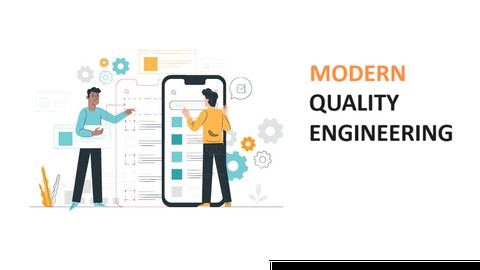
Masterclass Software Quality Engineering | AI Testing-2024
Masterclass Software Quality Engineering | AI Testing-2024, available at $69.99, has an average rating of 4.33, with 191 lectures, 4 quizzes, based on 300 reviews, and has 2980 subscribers.
You will learn about Learn modern ways to look at quality for software projects Apply continuous improvement techniques to increase speed and quality Leveraging the power of AI – CHAT GPT CI/CD Performance Tests with JMeter Use CHAT GPT to Create automated Performance Test Pipelines Understand how Shift Left on quality increases release cadence Identify pitfalls in the development process and their corrective actions Leverage the power of Continuous Testing Quality engineering principles applied to agile deliveries How to choose the right suited DEVOPS Testing pipeline Advanced Quality Assurance Testing Automation Test Pyramid and automation This course is ideal for individuals who are Quality Engineering Professionals or Engineering Managers or Full stack Testers or Quality Assurance Advisors It is particularly useful for Quality Engineering Professionals or Engineering Managers or Full stack Testers or Quality Assurance Advisors.
Enroll now: Masterclass Software Quality Engineering | AI Testing-2024
Summary
Title: Masterclass Software Quality Engineering | AI Testing-2024
Price: $69.99
Average Rating: 4.33
Number of Lectures: 191
Number of Quizzes: 4
Number of Published Lectures: 190
Number of Published Quizzes: 4
Number of Curriculum Items: 195
Number of Published Curriculum Objects: 194
Original Price: $79.99
Quality Status: approved
Status: Live
What You Will Learn
- Learn modern ways to look at quality for software projects
- Apply continuous improvement techniques to increase speed and quality
- Leveraging the power of AI – CHAT GPT
- CI/CD Performance Tests with JMeter
- Use CHAT GPT to Create automated Performance Test Pipelines
- Understand how Shift Left on quality increases release cadence
- Identify pitfalls in the development process and their corrective actions
- Leverage the power of Continuous Testing
- Quality engineering principles applied to agile deliveries
- How to choose the right suited DEVOPS Testing pipeline
- Advanced Quality Assurance
- Testing Automation
- Test Pyramid and automation
Who Should Attend
- Quality Engineering Professionals
- Engineering Managers
- Full stack Testers
- Quality Assurance Advisors
Target Audiences
- Quality Engineering Professionals
- Engineering Managers
- Full stack Testers
- Quality Assurance Advisors
This is a masterclass in Quality Engineering teaching the student how to properly approach quality validations by applying shift left and Right approaches, Dev Ops tool chain and Lean principles. This will provide an in dept analysis on how one can have preventive measures before the first line of code is written and how to maximize the return on the investment made in quality engineering.
The main goal of this course is to put together all the individual pieces that make software testing: Automation, Devops, Agile, Functional, Non-Functional, Version Control, Shift left and Shift Right, Containers, X as Code, Automated quality checks, Environments, Cloud and so on into one lecture that will bring these topics in a LEAN approach. This will take you from average Quality engineer to quality transformation expert.
You will see how to overcome the storming and norming phase in the team and reach the high performing state by looking at the model based on the five dysfunctions of the team.
After this lecture you will be able to improve the efficiency of your process, reduce infrastructure cost related to quality engineering, increase the speed of execution. By explaining LEAN Concepts and TIMWOODS wastes the project and organization will move to a continuous improvement and innovation state.
Course Curriculum
Chapter 1: Introduction
Lecture 1: Introduction
Lecture 2: The need to have this material
Lecture 3: Project Used In Course
Lecture 4: Trends – 3 powerful studies to keep you informed and connected
Chapter 2: Project Dependencies – Optional Lecture
Lecture 1: Installing Java
Lecture 2: Installing Maven
Lecture 3: Installing Visual Studio Code
Chapter 3: Misconceptions and Issues with quality engineering today
Lecture 1: Chapter Introduction
Lecture 2: Misconception – N-1 Automation
Lecture 3: Issue – Branching Strategy
Lecture 4: Problem – Bulk Delivery
Lecture 5: Misconception – Ice Cream Cone – Reverse Testing Pyramid
Lecture 6: Misconception – Testing after PR is closed
Lecture 7: Misconception – Siloes in the Project Organization
Lecture 8: Misconception – Testing = Quality Assurance
Lecture 9: Misconception – Environment Approach
Lecture 10: Summary of traps and misconceptions
Lecture 11: Free Performance Material – limited
Chapter 4: A Modern Approach to Quality Engineering
Lecture 1: A better approach to quality
Lecture 2: True Traceability of Functionalities
Lecture 3: Demo Traceability Jira- GitHub
Lecture 4: Modern outlook – Environments
Lecture 5: Modern outlook – Delivery of features
Lecture 6: Trunk Based Development
Lecture 7: Role of the quality engineer
Chapter 5: Shift Left Approach – Preventive Software Development
Lecture 1: Introduction to Shift Left
Lecture 2: Shift Left 6 Minute Testing Challenge
Lecture 3: What is Shift Left approach
Lecture 4: Examples of Shift Left Actions
Lecture 5: Benefits of Shift Left
Lecture 6: Enabler of Shift Left – Automation
Lecture 7: Demo – Automation First Approach
Lecture 8: Enabler of Shift Left – Bottom-Up approach
Lecture 9: Demo – Bottom-up Approach Enabler
Lecture 10: Enabler of Shift Left – Quality Policies
Lecture 11: Demo – Quality Policies – Enabler
Lecture 12: Enabler of Shift Left – Reutilization
Lecture 13: Demo- Reutilization – Enabler
Lecture 14: Enabler of Shift Left – Built in Quality
Lecture 15: Test Driven Development
Lecture 16: Demo – VS Code – Java – Test Driven Development
Lecture 17: Shift Left Cheatsheet
Lecture 18: What is Shift Right
Chapter 6: Understand Test Automation
Lecture 1: The Test Pyramid
Lecture 2: Practical Test Pyramid – Martin Fowler
Lecture 3: Ice-cream Cone Antipattern
Lecture 4: Automated Tests – Unit Tests
Lecture 5: Demo – Unit Tests – VS Code and Java
Lecture 6: Automated Tests -Integration Tests
Lecture 7: Automated Tests -Contract and API Tests
Lecture 8: Demo – Unit Tests – VS Code -RESTAssured and Java
Lecture 9: Automated Tests -UI Tests
Lecture 10: Practical Example of the Test Pyramid – Java
Lecture 11: Case Study – API and UI Test Automation Approach
Lecture 12: Cost and Speed Comparison API vs UI Automated Tests
Lecture 13: Test Automation Framework Design
Chapter 7: Quality Criteria for Continuous Integration / Branching
Lecture 1: Branching – Introduction
Lecture 2: Demo – Git – VS Code – GitHub – Branching – Merges – Pull Requests
Lecture 3: Branching – Important Metrics for Branches
Lecture 4: Branching – Strategies and tips
Lecture 5: Continuous Integration
Lecture 6: Practical Example – Blocking for Bad Code
Lecture 7: Demo – VS Code – Java – Super Linter -Practical example – Blocking failing tests
Lecture 8: Demo – Java – VS Code – JaCoCo- Practical example – Blocking for code coverage
Lecture 9: Demo- Java – OWASP – Practical example – Blocking for vulnerabilities
Lecture 10: Demo – GITHub – Practical example – Getting the build
Chapter 8: Continuous Testing / Delivery and Validations
Lecture 1: Continuous Deployment Pipe
Lecture 2: Environments – Modern Vision
Lecture 3: Environments – On Demand
Lecture 4: Environments – On Demand – Why/Benefits
Lecture 5: Environments – On Demand – How to make it work
Lecture 6: Practical example – Continuous Deployment with Automated Tests
Lecture 7: Feature Environments
Lecture 8: Practical Example – Feature/onDemand environment
Lecture 9: Nightly Build – Continuous Test Automation Concept
Lecture 10: Practical Example – The Nightly Run
Lecture 11: GitOPS
Lecture 12: Infrastructure Tests – Scalability / DR
Lecture 13: Pipeline Design Advice
Lecture 14: Performance validations
Lecture 15: Practical Example – Performance Validations
Lecture 16: How to approach DevOps for QE
Lecture 17: Design your pipeline
Chapter 9: Test Data for Test Automation – Strategy
Lecture 1: Introduction to Test Data
Lecture 2: Test Data – Use Application
Lecture 3: Test Data – Using Scripts
Lecture 4: Test Data – Using a Shared DB
Instructors
-

Dan Andrei Bucureanu
Quality Transformation Consultant
Rating Distribution
- 1 stars: 6 votes
- 2 stars: 11 votes
- 3 stars: 37 votes
- 4 stars: 108 votes
- 5 stars: 138 votes
Frequently Asked Questions
How long do I have access to the course materials?
You can view and review the lecture materials indefinitely, like an on-demand channel.
Can I take my courses with me wherever I go?
Definitely! If you have an internet connection, courses on Udemy are available on any device at any time. If you don’t have an internet connection, some instructors also let their students download course lectures. That’s up to the instructor though, so make sure you get on their good side!
You may also like
- Digital Marketing Foundation Course
- Google Shopping Ads Digital Marketing Course
- Multi Cloud Infrastructure for beginners
- Master Lead Generation: Grow Subscribers & Sales with Popups
- Complete Copywriting System : write to sell with ease
- Product Positioning Masterclass: Unlock Market Traction
- How to Promote Your Webinar and Get More Attendees?
- Digital Marketing Courses
- Create music with Artificial Intelligence in this new market
- Create CONVERTING UGC Content So Brands Will Pay You More
- Podcast: The top 8 ways to monetize by Podcasting
- TikTok Marketing Mastery: Learn to Grow & Go Viral
- Free Digital Marketing Basics Course in Hindi
- MailChimp Free Mailing Lists: MailChimp Email Marketing
- Automate Digital Marketing & Social Media with Generative AI
- Google Ads MasterClass – All Advanced Features
- Online Course Creator: Create & Sell Online Courses Today!
- Introduction to SEO – Basic Principles of SEO
- Affiliate Marketing For Beginners: Go From Novice To Pro
- Effective Website Planning Made Simple




















